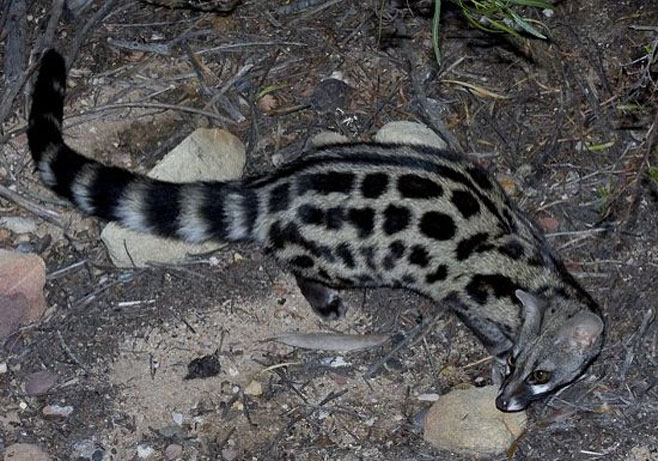|
Genetta tigrina (Large-spotted genet)
tigrine genet, blotched genet, rustyspotted genet [English];
grootkolmuskejaatkat, rooikolmuskejaatkat [Afrikaans]; Grossfleck Ginsterkatze
[German]; genetta a grandes taches, genette tigrine [French]; kanu [Swahili];
insimba [isiNdebele] [isiZulu] [siSwati]; inyhwagi [isiXhosa]; tshipa-thoko [Sepedi];
tshipa, t'sipa, tsipa e matheba a maholo [Sesotho]; tshipathokolo, thokolo [Setswana]; tsimba [Shona] [Tshivenda]; msimba-mangovo, nsimba [Xitsonga]; sipa [Lozi];
unsiimba [Yei]; !Noreb [Nama] [Damara]
Life
>
Eukaryotes >
Opisthokonta >
Metazoa (animals) > Bilateria > Deuterostomia >
Chordata > Craniata > Vertebrata (vertebrates) >
Gnathostomata (jawed vertebrates) > Teleostomi (teleost
fish) > Osteichthyes (bony fish) > Class:
Sarcopterygii (lobe-finned fish) > Stegocephalia
(terrestrial vertebrates) > Reptiliomorpha > Amniota >
Synapsida (mammal-like reptiles) > Therapsida > Theriodontia
> Cynodontia > Mammalia (mammals)
> Placentalia (placental mammals) > Laurasiatheria
> Ferungulata > Ferae > Carnivora >
Family: Viverridae (civets and genets)
> Subfamily: Viverrinae
 |
|
Genetta tigrina (Large-spotted genet),
Klipbokkop Mountain Lodge, South Africa. [photo Trevor Hardaker ©] |
A nocturnal carnivore with a varied diet that
includes mainly invertebrates and small rodents but also reptiles,
frogs, birds and wild fruits. Similar in appearance to the
Small-spotted genet but spots are larger and more rusty-brown, the
tail tip is usually dark-brown to black, the black-and-white facial
markings are less prominent, the chin is usually white, and it does
not have a crest of longer black-tipped along the spine.
Identification
Large-spotted genet has a long slender body and
tail and short legs. While there is considerable variation in colour
and patterning generally, the body is off-white to grayish white and
spotted with rusty-brown spots and bars, the legs are usually paler.
The spots are generally larger in size than in the Small-spotted
genet. Another difference between these two species is that the chin
is white and the long tail is ringed in black usually has a black
tip. Unlike the small-spotted genet there is no crest of longer
black hair along the spine. The ears are fairly elongated, rounded
and thin, they appear almost transparent. The eyes are large,
characteristic of its nocturnal lifestyle with distinct white
patches underneath. They have excellent binocular vision this allows
them to judge distances very accurately and jump from branch to
branch or on its prey. There are sharp, curved protractile claws on
both the front and back feet.
Size
Total Body Length: 85 – 110 cm; weight
range 1.5 – 3.2 kg.
Dental Formula:
I C C P P M M =
40 =
40
Distribution and habitat
Eastern areas of southern Africa and into the
south-western Cape to Cape Town. It is widely distributed throughout
the rest of Africa. Inhabits savanna woodland, and fynbos in the
Western Cape.
General behaviour
Large-spotted genets are nocturnal and lie up
and remain hidden during the day. They are good climbers and well
adapted to an arboreal way of life but also spend time foraging on
the ground. Normally solitary they are occasionally seen in pairs.
Genets are carnivores although insects and fruit are a regular part
of their diet. Excellent eyesight and their agility make them highly
effective predators. They combine speed and stealth, stalking their
prey in a series of dashes broken by short pauses. When stressed
they emit a strong musky odour from their anal glands and this smell
often indicates where they have urinated.
Food
Invertebrates and small rodents are primary
food, also eat reptiles, amphibians, birds and wild fruits.
Reproduction
The gestation period is about 70 days. A litter
of 2 – 4 young are born in summer in a nest hidden in holes, rock
crevices or amongst dense vegetation. They are blind at birth. The
eyes open after about 8 days and they venture from the nest soon
afterwards. They are weaned at 9 weeks although they eat solid food
before this. After a year the young are thought to be independent.
Life span
8 years maximum age.
Conservation
Large-spotted genets can come into conflict
with poultry farmers as they will kill for more birds than they
require if they get into a hen house. Unfortunately they are common
roadkills, becoming disorientated and trapped by car headlights at
night. The small-spotted genet is not regarded as threatened and its
conservation status is low risk.
|
